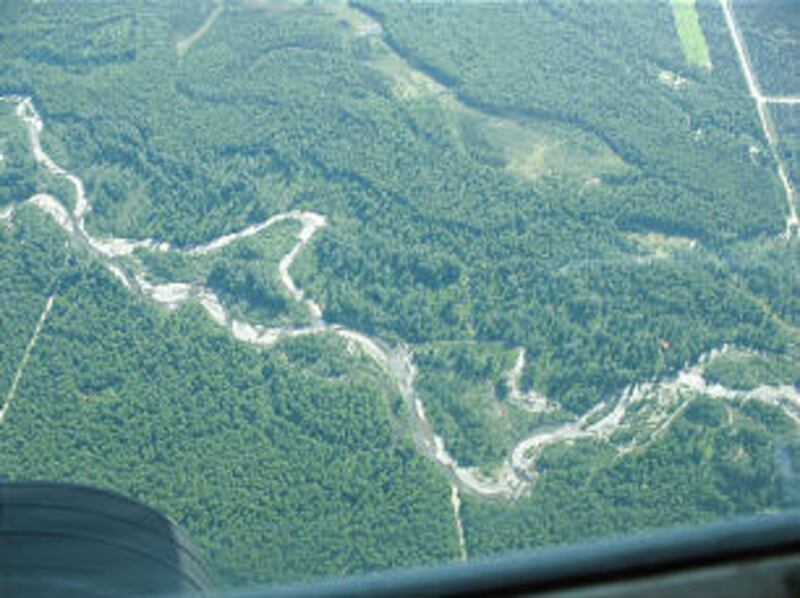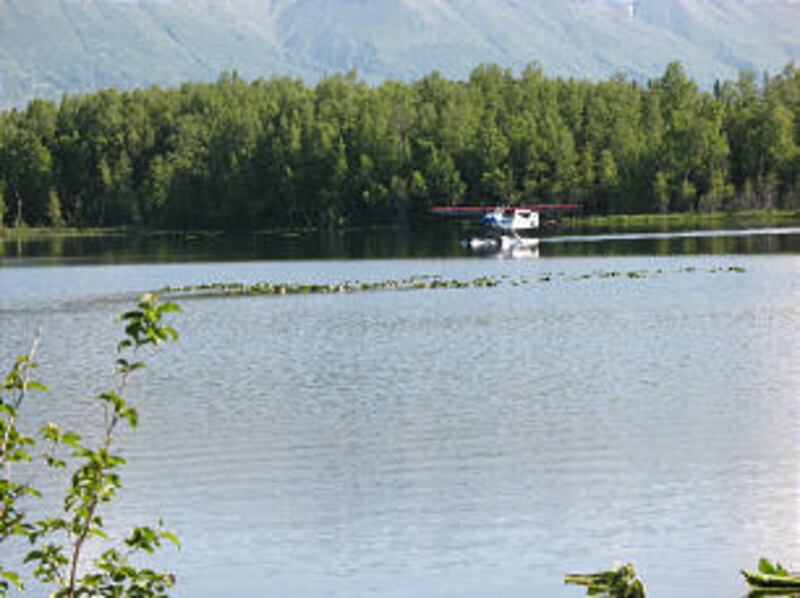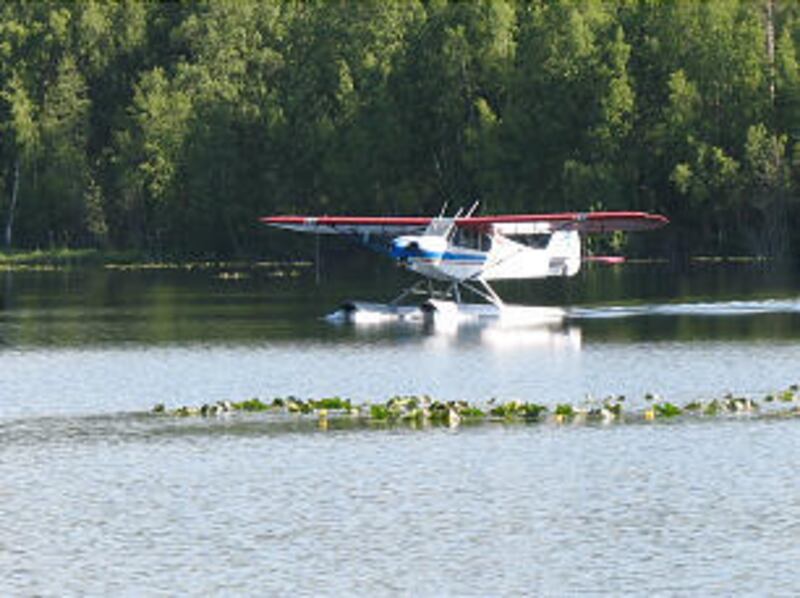PALMER, Alaska — My airplane splashed into the water and floated for a minute.
Then the pilot revved the Piper Cub's engine, and we skimmed across the Alaskan lake and took off again.
I'd thought being stuffed into a 2-person floatplane would trigger claustrophobia. I was going for this ride so I could say I'd done it. I strapped on my life vest, buckled my seatbelt, put on the headphones so I could talk to my pilot, and took a deep breath.
But as soon as we started gliding across the lake for takeoff, my neuroses slipped away, overwhelmed by pure delight. What a ride! What a view!
A landscape of pine forest and small lakes, glimmering in the summer sun, spread out below us. I had a fantastic view from both sides. We hopped from lake to lake, skimming the surface and taking off again.
I couldn't stop grinning if I tried.
(An etiquette note: Boaters and swimmers have the right-of-way in the water. Buzzing them to make them get out of the way would be "very bad form," as my pilot, Dale Olsen, put it.)
A small plane is a very Alaskan way to see the state. Small dirt airstrips punctuate the landscape of the south-central Matanuska-Susitna Valley — carved out of the forest or worn into the moraines at the foot of the glaciers. And for a plane on floats, every little lake (and there are plenty) is a potential landing spot in summer; a plane outfitted with skis can land on frozen lakes and on rivers in the winter, not to mention glaciers at any time of year.
With a huge, wild state and relatively few good roads (there are only about 50 miles of what we would recognize as an interstate), Alaskans and visitors find small planes useful for getting around, not to mention getting an eyeful of miles upon miles of wild beauty.
In fact, about 90 percent of Alaska cannot be reached by road, according to the Alaska Department of Transportation and Public Facilities. So per capita, Alaska has six times as many pilots as the rest of the United States, and 16 times as many aircraft.
Dozens of flying services operate in Alaska for tourists and non-pilot residents. Package trips are available for all sorts of fun: glacier landings, bear watching, flight-seeing, fishing, hunting, camping, and custom trips are available as well in this aviation-friendly state. Flights are always subject to change depending on the weather. Defer to your pilot's judgment.
Many of Alaska's delights are best reached by plane. It's the easiest way to get to Eagle, a small town on the Yukon River that epitomizes the rough pleasures of the Alaskan interior. (Scenery, history, mosquitoes, charm, permafrost and outhouses — permafrost is unfriendly to plumbing.) Yes, there's a road that'll get you there — a long, dusty, unpaved "highway" with turns and dropoffs particularly unfriendly to RVs. Or so I understand. I took the easy way ... overhead.
And there's no road to Cordova, a fishing town on Prince William Sound (where I had the best fish and chips ever): Everyone gets there by plane or boat (including the Alaska Marine Ferry). Talk of building a road to Cordova has stirred controversy for years. A road would improve access to food and other goods, but it would also dilute the fishing character that permeates the town.
We flew in a Cessna 180, which seats 4 to 5 (depending on weight), to land on a dirt strip near the Knik Glacier for a picnic. For those used to the long takeoff roll of passenger jets, the Cessna, which is built for short takeoffs and landings and rugged landing conditions, takes off in a breathlessly short distance. It's just plain fun. There's also something perversely enjoyable about being able to land without a paved runway.
We had guests at our cookout: hordes of enormous mosquitoes. In Utah, we stock up on sunscreen; Alaskans don't go anywhere without spraying insect repellent from head to toe. West Nile virus has not reached Alaska, but the mosquitoes are still to be feared.
In fact, we learned the "Matanuska" (named after the Matanuska River), sung to the tune of "Macarena":
Mosquitoes try to eat me so I do the Matanuska
Mosquitoes wanna eat me so I do the Matanuska
Mosquitoes gonna get me so I do the Matanuska
Heyyyy Matanuska!
(Sung while slapping yourself all over.)
Hurricane Turn train
Another way to see the wilderness is by train. The Hurricane Turn train — a former commuter train transplanted to the wilds of Alaska — is no beauty, but its route is stunning.
The trip starts at Talkeetna, the small town considered the gateway to Denali National Park (easily reached by plane or car), and curves north to the east of the park, paralleling the meandering Susitna River much of the way, then winding through the Indian River Canyon.
The train (the last whistle-stop train in America) is the only way to access this stretch of forested wilderness. We stopped to let hunters and rafters get off in the forest — no official stop, no platform; they just clambered down right into the forest — and when we passed a "town" of two or three buildings, with its inhabitants waving to us, the conductor tossed a newspaper to them.
After two hours or so of gazing at the wilderness, as we neared Hurricane, the conductor came through the train asking, "Is anyone here afraid of heights?" (Um, why do you ask?) The train then paused for 10 minutes on a heart-stopping trestle so passengers could take pictures of the gorge far below. In fact, the conductor opened the baggage door so passengers could get a view unobstructed by anything that might keep them safe. I kept my 6-year-old daughter far away from that particular attraction.
Views of Mount McKinley were plentiful along the way. To Alaskans, McKinley (also called Denali) is THE mountain. When an Alaskan acquaintance asked me after the train trip, "Was the mountain out?" I was pleased that I knew exactly what she meant: Was Mount McKinley free of the clouds that often obscure it? (It was.)
The Hurricane Turn has no dining car, and there is nowhere along the way to buy food, so all the passengers packed a lunch for the roughly 5-hour ride. One group, obviously on a guided tour, was served a variety of gourmet treats, down to chocolate-covered strawberries, which the guides had brought in coolers. Everyone else made do with their homemade sandwiches.
The train stopped at Hurricane (which appeared to be a collection of cars and fuel tanks; certainly no homes or stores) in the early afternoon for about 20 minutes, then headed back. Nearly all the passengers, full of lunch and glutted with scenery, nodded off despite the grand vistas rolling by.
E-mail: pwhitmore@desnews.com






